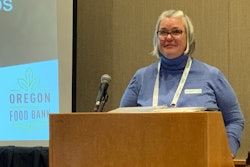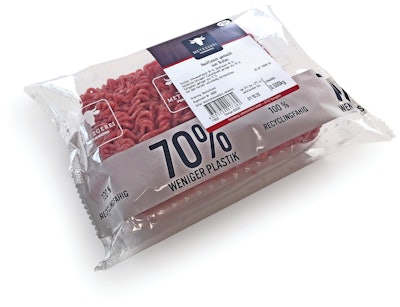
At the Harpak-ULMA PACK EXPO Las Vegas booth, a key emphasis was on a package format not seen very much in the U.S. but that is increasingly popular in Europe: trayless ground meat backflushed with a mix of oxygen and carbon dioxide and wrapped on a flow wrapper (1).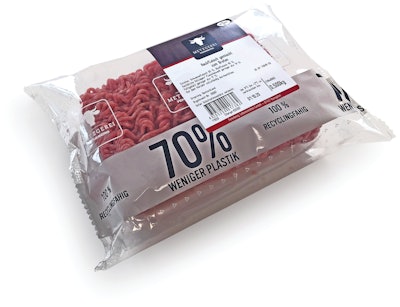 Image #1 in the article text.
Image #1 in the article text.
Harpak-ULMA Flow Wrap Product Manager Hugh Crouch, who also talked about the format at an Innovation Stage presentation, believes this concept has a shot at being adopted in the U.S. because by eliminating the tray there’s not only a cost savings but also a source reduction advantage. In addition to removing one whole piece of packaging by going trayless, you also eliminate the trucks and the fuel they would consume when trays need to be delivered. As Crouch puts it, “Just send a roll of film to the meat packer and that’s it.”
The Harpak-ULMA flow wrappers recommended for trayless ground meat are either the Ulma FM 300 for speeds to 70 packs/min or the FM 500 for up to 130 packs/min. The films being applied vary considerably according to shelf life requirements. European meat marketers are not inserting a soaker pad, paper only. Testing in the USA has been done both with and without a soaker pad. The jury is still out on whether it’s needed.
Crouch admits that, historically at least, the U.S. consumer has not been all that receptive to ground meat packaging formats other than the tray plus film overwrap. But considering how vociferous consumers have become where sustainability is concerned, he thinks it may be time to try this format in the U.S., and in fact testing is now underway. Crouch also points out that the shelf life of such packs in the U.S. marketplace would need to be longer than what is required in Europe due to the greater distances that fresh ground meat needs to travel on this side of the Atlantic. So the flexible films and gas mixtures used would likely need some tweaking.
Worth noting is that Harpak-Ulma wasn’t the only PACK EXPO exhibitor talking about trayless ground meat. A similar MAP flow wrap concept was on display at the Omori booth.
 |
As consumers put more emphasis on health, demanding more natural, fresh foods, interest is growing in High Pressure Processing (HPP) and what it can do to extend the refrigerated shelf lives of natural products. At PACK EXPO Las Vegas, JBT Avure introduced its FlexiBulk system (2), which is aimed at optimizing efficiency and throughput significantly. But to appreciate what a game-changer this innovation might be, it’s helpful to consider how HPP—the practice of extending refrigerated shelf life of packaged products by using high pressure to inactivate bacteria such as listeria, salmonella, and E. coli—has typically been done.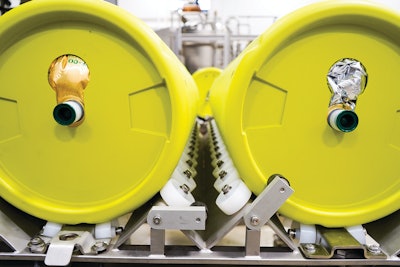 Image #2 in the article text.
Image #2 in the article text.
Historically, primary containers filled with product are placed into a large basket. It’s these baskets, after they’re filled with water, that enter the pressurizing chamber so that HPP can take place. It’s important to point out that containers made of only certain materials (primarily plastic) have been suitable for this process because things like glass or metal cannot maintain physical integrity and withstand the mechanical stress like plastic does under the intense pressure—up to 87,000 psi—involved in the process.
In recent years, innovative bulk HPP systems have helped broaden the range of packaging materials in which HPP product can be marketed. With this bulk processing approach, rather than putting filled primary containers into the HPP basket, a flexible film bag goes into the basket and then gets filled and closed. Next, the basket goes into the pressurizing chamber for the required pasteurization time. Then the basket exits the pressurizing chamber and its pasteurized contents are transferred to what’s referred to as an A-Tank. Needless to say, the interior of the A-Tank is cleaned to a level every bit as hygienic as the pasteurized product itself. From this A-Tank the product is filled into primary containers that are also sanitized to a level of cleanliness that is suitable for the pasteurized product. These containers, it’s important to point out, can be glass or metal because they don’t have to withstand the pressure of the HPP chamber. Why is this so important? Because plenty of food and beverage marketers who might be drawn to HPP are reluctant to embrace a technology that, until recently, required plastic packaging.
The downside to this bulk HPP approach is that it’s sequential. Only when all three critical processing steps—filling the bulk bag, pressurizing the bulk bag, and emptying the bulk bag’s contents into A-Tank—are completed can the next batch of product be filled into a bag and a new cycle begin. And that’s where FlexiBulk comes in. Rather than relying on one HPP basket that must be filled, processed, and emptied before the next batch can begin, FlexiBulk deploys multiple HPP baskets. This means that filling of the bulk bag, high-pressure processing of the bulk bag, and emptying of the bulk bag into A-Tank can all take place simultaneously, which greatly improves the throughput efficiency of the process. Also important is that the FlexiBulk baskets accept either bulk bags or single-serve plastic containers simultaneously. This is extremely attractive to toll processors who, because they produce for a wide variety of brand owner customers, value any measure of flexibility they can find.
But what really gets JBT Avure’s Sam Mudgal, Global Product Line Manager, excited is the increased throughput. “Efficiency in a basket is typically 40, 50, 60% max if a customer is doing conventional HPP, where single-serve bottles go into the basket, because there’s so much wasted space,”says Mudgal. “And if a customer is doing bulk HPP, they get the same suboptimal efficiency because until now that process was a sequential one. Now with FlexiBulk, efficiency is more than 90%, so we can actually double throughput.”
At JBT Avure’s PACK EXPO booth, Mike Stokes, Chief Supply Chain Officer for Los Angeles-based Pressed, said he was looking forward to the installation of a FlexiBulk system this past October. The cold pressed juice maker had been waiting for HPP to become more package-agnostic, according to Stokes. “Our consumers are all about sustainability,” he says, noting that Pressed wanted to be able to provide cold pressed juices in glass, aluminum, and carton containers, as well as plastic. “Not that plastic is not recyclable, but consumers don’t recycle.”
Flexibility is also key in how JBT Avure’s new system operates. “The FlexiBulk delivers the maximum in HPP flexibility—the ability to run bulk and in-package products in the same cycle,” says Ryan Pereira, president of JBT Avure. In this case of course, a bulk bag would occupy one basket and the in-package products would occupy a separate one.
Pressed runs a variety of bottle sizes for its juices. Running its 2-oz shots in PET bottles in an HPP basket maximizes the pack efficiency, since the small bottles can be packed so densely. Pressed plans to run a bulk bag in one carrier of the machine while running the 2-oz bottles in the second carrier.
“The throughput vs. other bulk systems is profoundly different,” Stokes says, noting the benefits of FlexiBulk doing the basket filling and basket unfilling outside of the HPP press, thereby improving the speed and efficiency of bulk HPP.
 Image #3 in the article text.
Image #3 in the article text.
“HPP has always been niche,” Mudgal says. “With this, we’re really making it mainstream.”
 | Watch a video of the FlexiBulk. |
The Urschel TranSlicer (ETRS) cutter (3) features a built-in discharge conveyor, which facilitates the dispensing of cut product into totes. The built-in conveyor also assists with the effective capture of slivered, small cuts of leeks, onions, or peppers to promote complete discharge from the machine. Hinged/sliding panels offer full access to all key areas of the machine to simplify maintenance and washdowns, while sloped surfaces throughout the machine, including a self-draining frame, make cleaning easier. Engineered for elongated food products, the belt-fed unit employs different styles of 20-in diameter cutting wheels to create flat or crinkle slices and julienne cuts.
“The design of the Urschel E TranSlicer (ETRS) cutter streamlines processing with minimal elevation changes, plus controlled and contained transfer points, to ensure maximum product is processed,” explains Urschel Laboratories CSO Alan Major.
Built for reliability, efficiency, and longevity, the VDG IntelliDrive drum motor (4) features variable belt speed without torque reduction and a permanent magnet electric motor that is enclosed inside the drum, along with the gear reducer and gears. The drum motor has a service life of 80,000 hr before scheduled maintenance. For sanitary food belt conveyor applications, the all-316-stainless-steel motor is available with the belt profile machined onto the drum that drives the modular belts without the use of sprockets.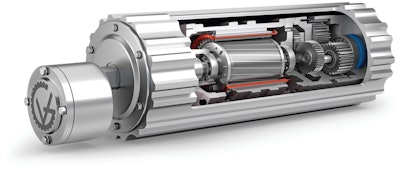 Image #4 in the article text.
Image #4 in the article text.
“The difference with the VDG drum motor is that all components, including the motor and gear reducer, are enclosed inside the drum, providing a compact, space-saving solution that is up to 96% mechanically efficient and consumes 30% less energy,” states VDG Heavy Industry Drive Specialist Matt Lepp.
The Tippmann Group Pallet Fit door (5) makes the company’s QFR Zone blast freezing system more flexible and efficient than ever before. The door allows pallets of all sizes to be placed in the QFR Zone system, including full pallets, partial pallets, single-layer pallets, or no pallet, eliminating the need for plug pallets. As pallets are placed into the system, the door engages only where there is product, opening and allowing maximum airflow through the product while eliminating wasted airflow. The door also is available with the QTR Zone solution for thawing palletized product. Image #5 in the article text.
Image #5 in the article text.
“The QFR Zone Pallet Fit door provides optimum flexibility for our customers, so they can tackle any situation,” says Sean Slain, Tippmann Group Vice President of Sales. “This cutting-edge technology was designed from customer feedback. We listened, and we delivered a system [QFR Zone Pallet Fit door] that provides maximum operational flexibility and labor savings to our customers.”

















